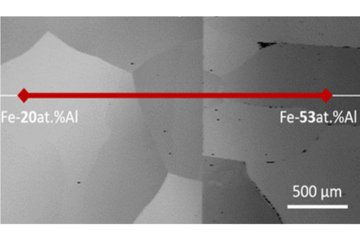All genres
21.
Journal Article
Influence of Microstructure and Atomic-Scale Chemistry on Iron Ore Reduction with Hydrogen at 700°C. Acta Materialia 212, 116933 (2021)
22.
Journal Article
Morphological evolution of Pt-modified nanoporous gold after thermal coarsening in reductive and oxidative environments. npj Materials Degradation 4 (1), 40 (2020)
23.
Journal Article
Enabling near-atomic–scale analysis of frozen water. Science Advances 6 (49), eabd6324 (2020)
24.
Meeting Abstract
Advances in Cryo-Atom Probe Tomography Studies on Formation of Nanoporous Metals by Dealloying (Digital Presentation). In ECS Meeting Abstracts, MA2022-01 (47), p. 1983. The Electrochemical Society (2022)
25.
Talk
Development of Thin-Film Nanoporous Ruthenium Electrocatalysts Using Atom Probe Tomography. 245th The Electrochemical Scoiety (ECS) Meeting, San Francisco, CL, USA (2024)
26.
Talk
Probing Dealloying Mechanisms in Thin-Film Nanoporous Metals Using Atom Probe Tomography. Atom Probe Tomography & Microscopy, Leuven, Belgium (2023)
27.
Talk
GIS-free metal coating in cryo-FIB: methods and use cases. IMC20 - 20th International Microscopy Congress, Busan, South Korea (2023)
28.
Talk
Observations on Improved Cryogenic Lift-Out Methods: Optimised Sample Preparation. Talk at Korea Institute of Science and Technology, Seoul, South Korea (2023)
29.
Talk
Materials Degradation: Turning a problem into a solution. Colloquium on Integrated Metallic Nanomaterials Systems, Hamburg, Germany (2021)
30.
Talk
Towards Enhanced Atom Probe Tomography Characterization of Wet Corrosion Systems. (SCI Electrochemistry Postgraduate Conference, Manchester, UK (2021)
31.
Talk
Sustainable Metals. Virtual Keynote Perspective Lecture, Materials Chain and Materials Science Department, RUB
, Bochum, Germany (accepted)
32.
Talk
Basic Research Opportunity and Leverage Effects in Sustainable Metallurgy. Workshop: New Frontiers in Materials Science and Engineering – Sustainable Metallurgical Processes with improved CO2 efficiency, RWTH Aachen, online, Aachen, Germany (2020)
33.
Talk
Nanoparticle Specimen Preparation for Atom Probe: Chemical Fixation and… cryo-Fixation (?). TMS 2020 Annual Meeting & Exhibition, San Diego, CA, USA (2020)
34.
Talk
Characterization and Functional Improvement of Nanoporous Metals. 236th ECS Meeting, Atlanta, GA, USA (2019)
35.
Teaching
Introduction to Atom Probe Tomography. Lecture: IMPRS-SurMat, August 2021, MPIE Düsseldorf
36.
Teaching
Sustainable Materials Science and Green Metallurgy (Sustainable Materials and Metallurgical Science & Engineering). Lecture: SS 2021, RWTH Aachen University, 2021-04 - 2021-07
37.
Preprint
The fate of water in hydrogen-based iron oxide reduction. arXiv (2023)
38.
Preprint
B dopant evolution in Pd catalysts after H evolution/oxidation reaction in alkaline environment. arXiv (2023)
39.
Preprint
Scalable Substrate Development for Aqueous Biological Samples for Atom Probe Tomography. arXiv (2023)
40.
Preprint
Nanoporous gold thin films as substrates to analyze liquids by cryo-atom probe tomography. arXiv (2023)











